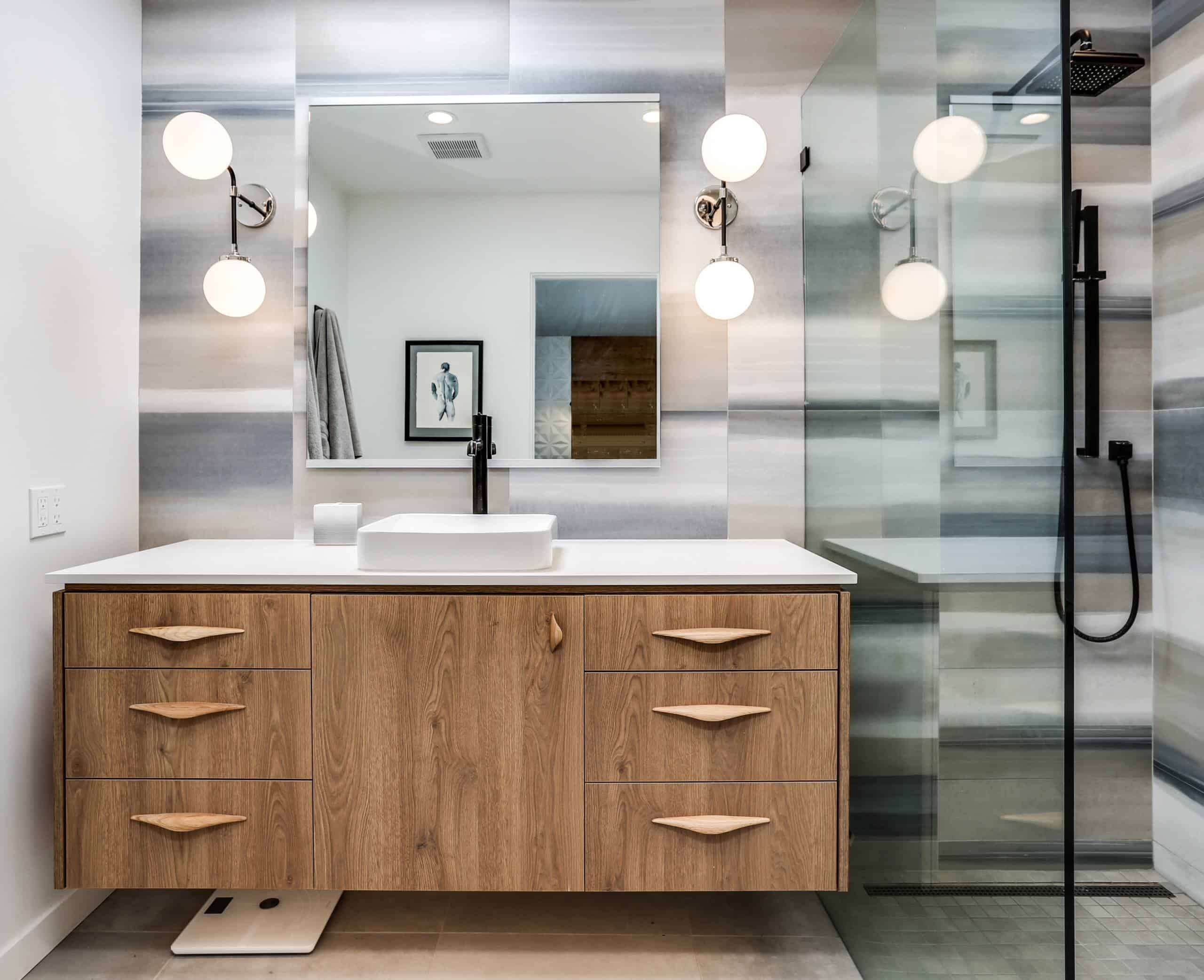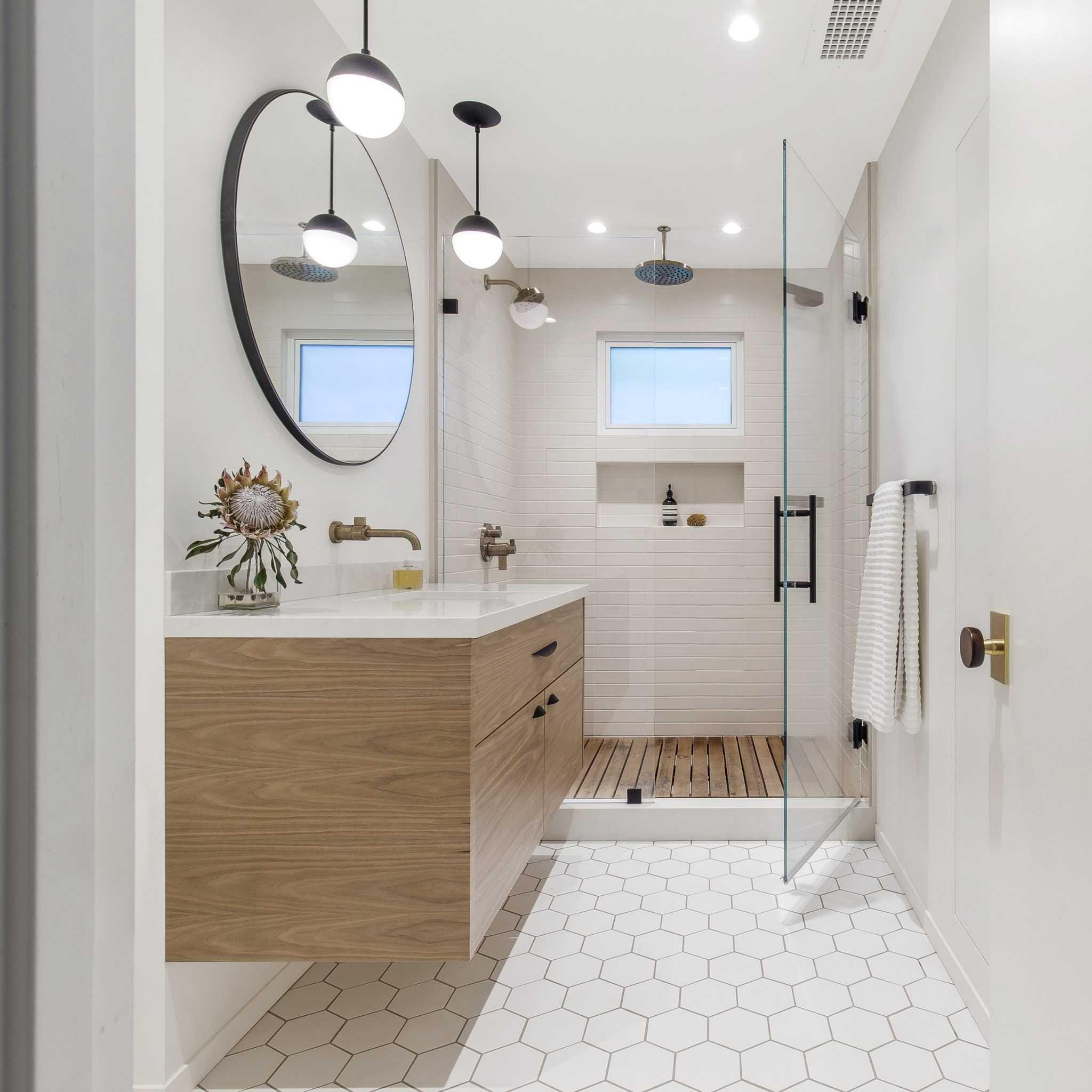Defining Modern Architecture in Bathroom Design

Modern architecture, known for its clean lines, minimalist aesthetics, and functionality, has significantly influenced bathroom design, creating spaces that are both stylish and practical.
Core Principles of Modern Architecture
Modern architecture emphasizes simplicity, functionality, and a connection to the natural world. These principles translate into bathroom design by prioritizing open spaces, natural light, and streamlined fixtures.
Key Characteristics of Modern Bathrooms
Modern bathrooms are characterized by their clean lines, minimalist aesthetics, and functionality.
- Clean Lines: Modern bathrooms feature simple, geometric shapes and minimal ornamentation. This creates a sense of order and tranquility.
- Minimalist Aesthetics: Modern bathrooms prioritize functionality over excess. They feature simple, streamlined fixtures and minimal decorative elements.
- Functionality: Modern bathrooms are designed to be practical and efficient. They feature well-organized storage solutions and easy-to-clean surfaces.
Examples of Iconic Modern Architects and their Contributions to Bathroom Design
Many iconic modern architects have contributed to the evolution of bathroom design.
- Mies van der Rohe: Mies van der Rohe, known for his “less is more” philosophy, designed bathrooms with simple, geometric forms and minimal ornamentation. He emphasized the use of natural materials like marble and wood.
- Le Corbusier: Le Corbusier, another influential modern architect, emphasized functionality and efficiency in his bathroom designs. He used modular elements and open spaces to create practical and comfortable bathrooms.
- Frank Lloyd Wright: Frank Lloyd Wright, known for his organic architecture, designed bathrooms that seamlessly integrated with the natural environment. He used natural materials like stone and wood, and incorporated elements of nature like light and air into his designs.
Materials and Finishes for Modern Bathrooms: Modern Architecture Bathroom Design

Modern bathroom design is characterized by its minimalist aesthetic, clean lines, and functional elements. The choice of materials plays a crucial role in achieving this look and feel, contributing to the overall atmosphere and durability of the space.
Natural Stone
Natural stone is a popular choice for modern bathrooms due to its inherent beauty and timeless elegance. It comes in a wide variety of colors, textures, and patterns, allowing for customization and unique design expressions.
- Marble: Marble is known for its luxurious appearance and veining patterns. It is a durable material that can withstand high traffic and moisture, making it suitable for countertops, floors, and walls. However, it is porous and requires regular sealing to prevent staining.
- Granite: Granite is a highly durable and resistant material that is often used for countertops and floors in modern bathrooms. It is known for its durability and stain resistance, making it a practical choice for high-traffic areas.
- Limestone: Limestone is a softer stone with a more subtle appearance compared to marble or granite. It is often used for walls and floors, creating a calming and elegant atmosphere. However, it is more susceptible to scratches and stains.
Concrete
Concrete is gaining popularity in modern bathroom design for its industrial and contemporary aesthetic. It offers a clean, minimalist look and can be customized with various finishes and colors.
- Polished Concrete: Polished concrete floors and countertops offer a sleek and reflective surface that adds a touch of sophistication to modern bathrooms.
- Stained Concrete: Concrete can be stained in various colors to create unique patterns and textures, adding visual interest to the space.
- Concrete Tiles: Concrete tiles are available in various sizes and shapes, offering versatility in design and installation. They provide a durable and water-resistant surface, making them suitable for walls and floors.
Wood
Wood is a natural material that brings warmth and character to modern bathrooms. It can be used for various elements, such as vanities, cabinets, and flooring.
- Teak: Teak is a durable hardwood known for its water resistance and natural oils that protect it from decay. It is often used for flooring and furniture in modern bathrooms.
- Walnut: Walnut is a beautiful wood with rich color variations and a distinctive grain pattern. It is commonly used for vanities and cabinets in modern bathrooms.
- Bamboo: Bamboo is a sustainable and fast-growing material that is becoming increasingly popular in modern bathroom design. It is lightweight, durable, and naturally resistant to moisture.
Other Materials, Modern architecture bathroom design
- Glass: Glass is a versatile material that is commonly used for shower enclosures, partitions, and vanities in modern bathrooms. It offers a sleek and modern aesthetic and can be customized with different finishes and textures.
- Metal: Metal is often used for accents and fixtures in modern bathrooms, adding a touch of industrial chic. Stainless steel, chrome, and brass are popular choices for faucets, towel bars, and other hardware.
- Ceramic: Ceramic is a durable and affordable material that is commonly used for tiles in modern bathrooms. It comes in a wide variety of colors, patterns, and textures, offering versatility in design.
Table of Materials and Properties
| Material | Properties | Advantages | Disadvantages | Examples of Use |
|---|---|---|---|---|
| Natural Stone (Marble, Granite, Limestone) | Durable, natural, beautiful, porous | Adds elegance and sophistication, versatile in design | Requires sealing, can be expensive | Countertops, floors, walls |
| Concrete | Durable, industrial, customizable | Offers a clean and modern aesthetic, can be stained or polished | Can be cold to the touch, requires proper sealing | Floors, countertops, walls, tiles |
| Wood (Teak, Walnut, Bamboo) | Warm, natural, durable, water-resistant (some types) | Adds warmth and character to the space, sustainable | Requires maintenance, can be susceptible to moisture damage | Vanities, cabinets, flooring |
| Glass | Sleek, modern, versatile | Offers a spacious and airy feel, can be customized with different finishes | Can be fragile, requires careful cleaning | Shower enclosures, partitions, vanities |
| Metal (Stainless steel, chrome, brass) | Durable, sleek, modern | Adds a touch of industrial chic, resistant to corrosion | Can be cold to the touch | Faucets, towel bars, other hardware |
| Ceramic | Durable, affordable, versatile | Comes in a wide variety of colors and patterns, easy to clean | Can be prone to scratches, limited design options compared to natural stone | Tiles for walls and floors |
Key Design Elements of a Modern Bathroom

A modern bathroom design prioritizes functionality, clean lines, and a minimalist aesthetic. This is achieved by carefully considering the layout, lighting, color palette, and fixtures.
Maximizing Space and Functionality in a Modern Bathroom Layout
A well-designed modern bathroom layout maximizes space and functionality by prioritizing efficient use of square footage. This is achieved through a combination of smart design choices and the integration of storage solutions.
- Open Floor Plan: Eliminating unnecessary walls and creating an open floor plan can make a bathroom feel larger. For example, combining a shower and bathtub into a single wet area can create a sense of spaciousness.
- Strategic Placement of Fixtures: The placement of fixtures such as the toilet, sink, and shower should be carefully considered to ensure optimal flow and accessibility. A good rule of thumb is to place fixtures at least 30 inches apart to allow for easy movement.
- Vertical Storage: Utilizing vertical space is essential in maximizing a bathroom’s functionality. This can be achieved by incorporating tall cabinets, shelves, and even wall-mounted storage solutions.
Lighting in Modern Bathroom Design
Lighting plays a crucial role in creating the desired atmosphere and functionality of a modern bathroom. Proper lighting can enhance the overall design, highlight key features, and create a sense of spaciousness.
- Natural Light: Maximize natural light by using large windows and skylights. This can create a bright and airy feel, reducing the need for artificial lighting during the day.
- Layered Lighting: Employing a combination of ambient, task, and accent lighting can create a balanced and functional lighting scheme. Ambient lighting provides overall illumination, task lighting is focused on specific areas like the vanity, and accent lighting highlights specific features like artwork or architectural details.
- LED Lighting: LED lights are energy-efficient and long-lasting, making them an excellent choice for modern bathroom design. They also offer a wide range of color temperatures, allowing for customized lighting effects.
Color Palettes and Modern Bathroom Aesthetics
Color plays a significant role in shaping the mood and aesthetic of a modern bathroom. Neutral palettes with pops of color are common in modern design, creating a clean and sophisticated look.
- Neutral Base: A neutral base, such as white, gray, or beige, provides a clean canvas for incorporating other design elements.
- Accent Colors: Pops of color can be introduced through towels, rugs, artwork, or even the choice of fixtures. Popular accent colors in modern bathroom design include black, navy, emerald green, and terracotta.
- Monochromatic Schemes: A monochromatic color scheme, using different shades of the same color, can create a sense of sophistication and continuity. For example, using varying shades of gray can create a calming and elegant atmosphere.
Modern Bathroom Fixtures and Their Impact on Design
Modern bathroom fixtures are characterized by their sleek lines, minimalist design, and innovative functionality. They play a crucial role in creating the desired aesthetic and enhancing the overall user experience.
- Floating Vanities: Floating vanities create a sense of spaciousness and add a contemporary touch to the bathroom. They also offer increased storage space underneath, maximizing functionality.
- Walk-in Showers: Walk-in showers are a popular choice in modern bathrooms, providing easy accessibility and a luxurious feel. They often feature frameless glass doors, creating a seamless and modern aesthetic.
- Integrated Storage Solutions: Modern bathrooms often incorporate integrated storage solutions, such as built-in shelves, drawers, and niches, to minimize clutter and maximize functionality.
Modern Bathroom Design Trends
Modern bathroom design is constantly evolving, with new trends emerging regularly. Some of the latest trends include:
- Smart Technology: Integrating smart technology into the bathroom is becoming increasingly popular. This can include features like voice-activated controls for lighting and temperature, smart mirrors with integrated displays, and automated toilet systems.
- Sustainable Materials: The use of sustainable materials, such as recycled wood, bamboo, and natural stone, is becoming increasingly important in modern bathroom design. These materials are environmentally friendly and contribute to a more sustainable lifestyle.
- Geometric Patterns: Geometric patterns are making a comeback in modern bathroom design, adding a touch of visual interest and sophistication. This can be achieved through the use of tiles, wallpaper, or even bathroom accessories.
Modern architecture bathroom design often emphasizes clean lines and minimalist aesthetics, creating a sense of spaciousness and tranquility. A key element in achieving this is selecting the right paint for the ceiling, which can impact the overall ambiance. When considering options for a bathroom ceiling, it’s essential to choose a paint that is moisture-resistant and mildew-resistant, such as a high-quality acrylic latex paint.
This type of paint not only protects the ceiling but also creates a smooth, even finish that complements the clean lines of modern architecture.
Modern architecture bathroom design often emphasizes clean lines, minimalist aesthetics, and the use of natural materials like Carrara marble. To complement this style, choosing the right paint color is crucial. A well-chosen hue can enhance the marble’s natural beauty and create a cohesive atmosphere.
For inspiration on finding the perfect paint color for your Carrara marble bathroom, explore this comprehensive guide on best paint colors for a Carrara marble bathroom. By carefully selecting the right paint color, you can elevate your modern bathroom design and create a truly sophisticated space.